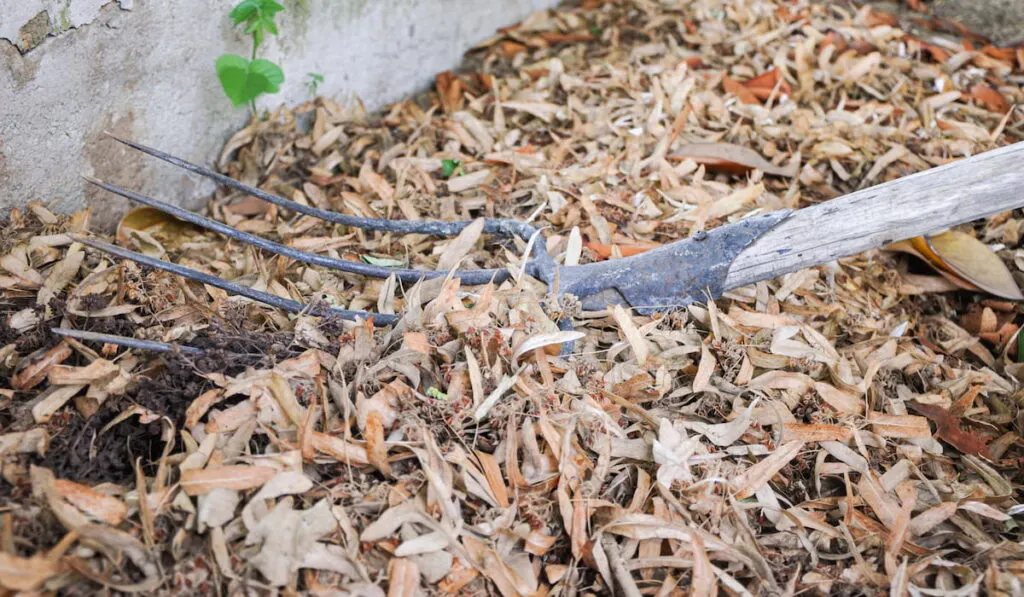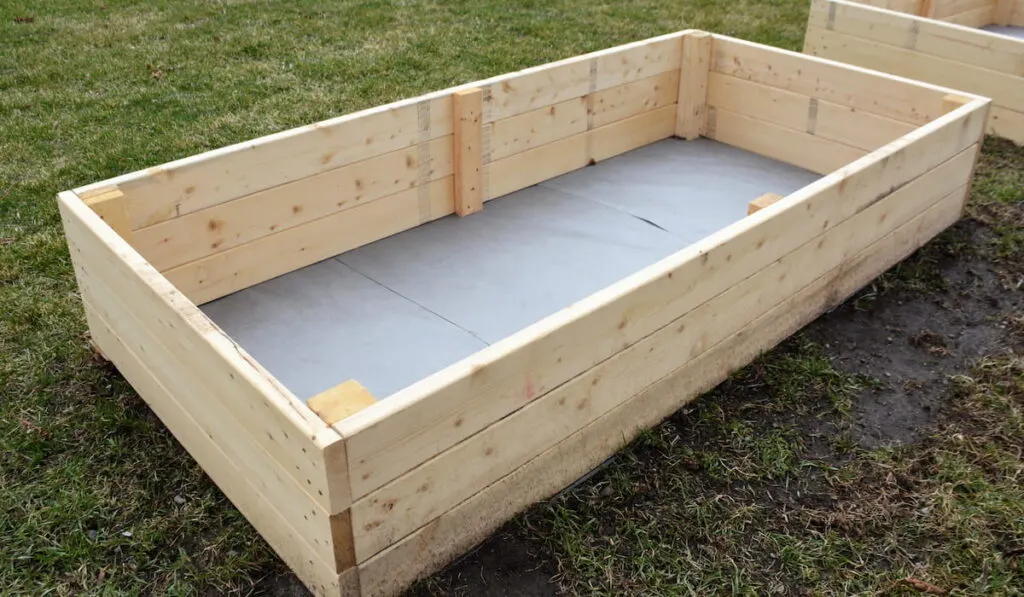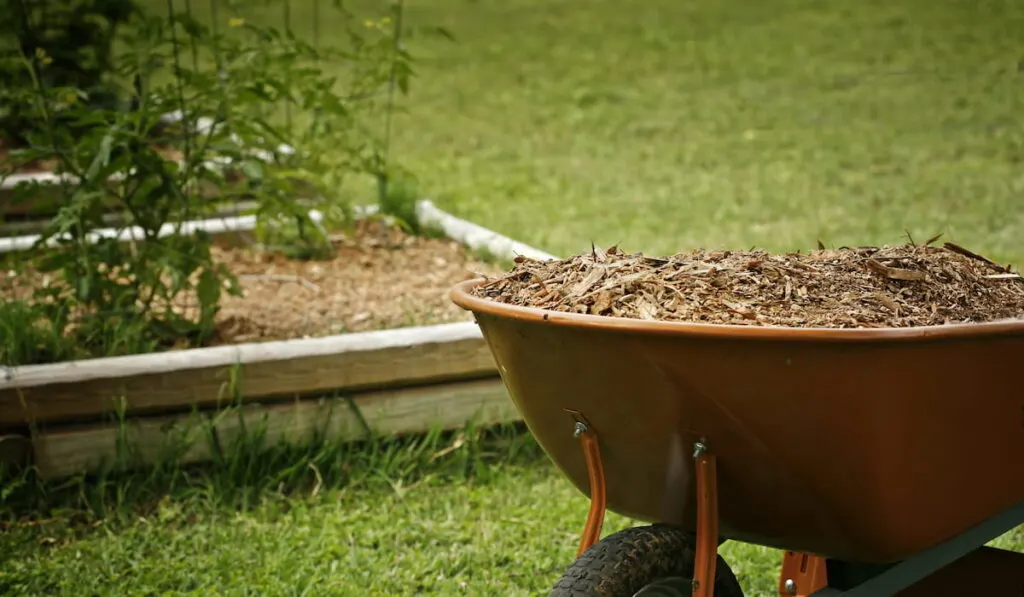Mulch has many benefits for all types of gardens, including raised beds. It helps maintain soil moisture, suppresses weeds, and regulates soil temperature, amongst other things. However, there are different types of mulch, and you may need to be selective when choosing one for your garden beds.

How do you pick the perfect mulch for raised beds? In mulching gardens, a few factors are often considered.
The plants, the soil, the cost, and the gardener’s preference are some factors that determine the perfect mulch.
The ease of applying the mulch, the color, and its availability are also important considerations.
Sometimes, gardeners prefer certain types of mulch over others. But each type offers benefits and drawbacks.
Evaluating the benefits and drawbacks of each type of garden mulch will be helpful as you pick the best for your garden.
Table of Contents
Types of Garden Mulch
There are two main types of garden mulch: organic mulches and inorganic mulches.
Organic Mulches
As the name indicates, organic mulches come from natural sources. They are obtained from various plant materials, including the following:
Leaves

Leaves are easy to get. They can even come from your won yard. When applied to the soil as mulch, leaves break down over time and release nutrients.
When applying leaves as mulch, the best approach is to shred them. When shredded, they stay in place longer and decompose faster.
The main drawback of leaf mulch is when it becomes sodden. When wet, leaf mulch can reduce soil aeration and may cause the plants to suffocate.
Pine Needles
If your garden is sloped, pine needles might be the ideal mulch because they stay in place well. They break down slowly and can help if you are trying to make the soil more acidic.
Pine needles can make your garden more beautiful because they take on a silvery-grey hue as they age.
Shredded or Chipped Barks
Shredded and chipped barks are commonly used as mulch. As they slowly decompose, they enrich the soil and stimulate plant growth.
Shredded barks are available in different colors and types, namely softwood barks and hardwood barks.
Softwood barks, such as pine, hemlock, or cedar barks, are more resilient and take longer to decompose. Hardwood types decompose faster and have to be replaced frequently for continuous effect.
Straw/Hay
Straw is easy to come by and inexpensive. It also decomposes rapidly, enriching the soil during the growing season.
Because of its quick decomposition, straw has to be replaced frequently.
You may do this by checking the depth of the straw every 4-6 weeks and adding to it when it becomes thin.
Straw is also light, which is helpful for transport, but it also means the wind can carry it away. In addition, burrowing animals and rodents can be attracted to the protection straw mulch offers.
Compost
Corncobs, coffee grounds, leaves, kitchen waste, and many other organic materials can be used in making compost.
When used as mulch, compost persists for a long time, and constantly enriches the soil. Besides enrichment, compost can help remove soil toxins.
The biggest drawback to using composts as mulch is the possibility of having weed seeds in them.
Grass Clippings
Grass clippings are best applied when dry. Spread grass clippings in thin layers to avoid them becoming hot, slippery, and smelly underfoot.
If you need nitrogen for your soil, grass clippings will do the job as they decompose. Never use clippings from sources that have been treated with chemicals such as fertilizers or pesticides.
Newspaper
Newspaper qualifies as an organic mulch since it does decay. As a mulch, it helps repress weeds and prevent plant encroachment.
The inks used in old newspapers were toxic, but in recent times they are made from water and other non-toxic materials. But you may still find some that use toxic materials, so choose your newspaper carefully.
When using newspaper as mulch, water it to hold it down. You can also cover it with soil and other organic mulches. A benefit of newspaper is that it does not block microorganisms or water from penetrating through to the soil.
Inorganic Mulches
Inorganic mulches are artificial materials, and they include the following:
Landscape Fabric

Landscape fabric stifles weed growth. It allows water, air, and fertilizer through, but you should avoid using it with organic mulches.
Landscape fabric works really well if you place it below gravel and decorative stones. Without fabric, these materials can sink in the soil and promote soil compaction. The gravel or stones also help secure the fabric to the ground.
The drawback here is that the fabric can make it hard to remove weeds.
Black Plastic
Black plastic mulch represses weeds, retains water in the soil, and helps increase soil temperature. The extra warmth provided by this material can help during short growing seasons.
The increase in temperature facilitated by black plastic can also be detrimental to plants. You should monitor the temperature or place some organic mulch on it to decrease direct exposure to the sun.
Over time, sunlight causes damage to black plastic. Placing organic mulch over it helps prevent this.
Silver Plastic
Silver plastic performs similar functions to black plastic, except it does not suppress weed growth. As seen with black plastic, silver plastic will also increase soil temperatures and may require shading. Organic mulch can be used with silver plastic as well.
Ideal Mulch Depth
As much as mulches can improve your garden, you should be wary to avoid overapplication of mulches.
Excess mulch will reduce aeration and suffocate your plants.
The ideal mulch depth depends on the type of soil in your garden and the particle size of the mulch.
Mulch on heavy soils should have a depth of 2-3 inches. A mulch layer 2-4 inches deep is typical for lighter, well-drained soils.
If you are using fine mulch, apply a layer about 2 inches thick on the soil. But with coarser mulches, 3-4 inches works well.
Tips for Mulching Your Garden
- Do not heap mulch or apply it excessively. This may suffocate the plants or make their roots grow shallowly.
- Apply mulch at least 1 inch away from the stem of the plant to avoid fungal infections and rot.
- When applying mulch to the base of a tree, apply it in a saucer shape, starting 1 inch out from the trunk.
- Do not use grass clippings (or any mulch) tainted with toxic chemicals.
- Barks and wood mulches are great for flower gardens and landscaped areas with infrequent digging.
- For vegetable gardens, light mulches such as straw or hay work better since they mix with the soil easily.
- Using older, composted leaves (about 9 months old) as mulch reduces the possibility of any growth-inhibiting constituents remaining (only some species have these).
- If you intend to inhibit the growth of weeds, do not use a mulch layer less than 2 inches.
- Apply mulch in winter/fall when the ground is frozen for protection of tender plants. Aim for a mulch depth of 3-4 inches.
- When spring comes and the soil thaws, reduce the depth to 2 inches to encourage new growth.
Does the Color of the Mulch Matter?

The color of mulch does matter. For one, it affects the appearance of your garden.
Some gardeners prefer to have colored mulches, something to give their landscape an attractive look. Others do not like it because they consider it unnatural.
Natural mulches lose their color with exposure to sunlight and weather, leaving a bland look. Colored/dyed mulches do not fade as easily.
Colored mulches are commonly available in three colors: red, brown, and black. But you may also find other colors.
In some quarters, red mulch is believed to aid the growth of some vegetables and fruits. This color is the most vibrant, but many people prefer the other two (black and brown).
Black mulches retain heat more than red or brown and are better at making the soil warm. The brown types look the most natural of the three.
You may also want to consider the colors of the flowers in the garden or the colors of surrounding structures when choosing a colored mulch.
When getting a colored mulch, handle it carefully to avoid staining skin, concrete, or clothing. Also, ensure that the dye used on the mulch you buy is non-toxic.
Mulches That Help Prevent Weeds
Generally, inorganic mulches offer better weed suppression than organic mulches. However, if you have a weed problem in your garden beds or you are trying to avoid one, consider the following mulches:
- Sawdust
- Shredded bark
- Wood chips
- Shredded leaves
- Straw
- Grass clippings
- Landscape fabric
- Black Plastic
Do Raised Beds Need Mulch?
Although weeds growing in raised beds are less of a problem, raised beds do benefit from mulching. Mulches further suppress the growth of weeds.
Besides reducing weeding, mulches also help retain water in raised beds, which may dry out faster than in-ground gardens.
Mulch can also help with soil temperature control and soil enrichment in raised beds.
Conclusion
Choosing the ideal mulch for your raised beds is important but not complex. Once you know what your plants and soil need, and the depth you should apply it, you can decide which mulch material fits best for your garden.
Resources
- https://www.lowes.com/n/how-to/landscaping-with-mulch
- https://hortnews.extension.iastate.edu/faq/how-deep-should-mulch-layer-be-around-trees-and-shrubs
- https://frador.com/what-is-the-best-mulch-for-vegetable-gardens/
- https://www.almanac.com/news/gardening/gardening-advice/mulching-guide-benefits-mulch
- https://www.sylvacorp.com/the-importance-of-mulching
- https://blog.davey.com/2019/05/what-type-of-mulch-to-choose-mulch-selection-guide
- https://getbusygardening.com/mulching-vegetable-garden/
- https://www.loveyourlandscape.org/expert-advice/shrubs-and-flowers/basic-care/mulching-tips-from-the-pros/
